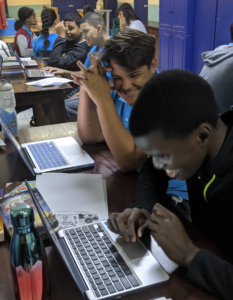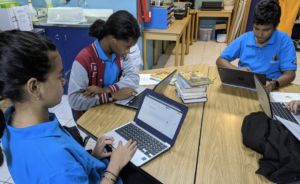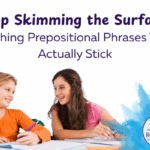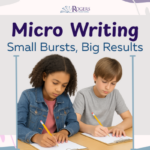I am a huge proponent of the Writers’ Workshop model. However, those who have been to my workshops know that I am not a purest. I do believe that there are times when we have to break from the model and tweak things a little bit to allow for the reality of state mandates, testing, success in university, etc. But, overall, I use and endorse the model.
So confusion sets in when my 8th-grade students have to enter into the unit of research. How can I stay true to the Writers’ Workshop model while doing what I know to be best practice in research: providing a choice of topic, allowing students to advance through the process at their own speed, having students create multiple drafts at the same time, etc?
The Dilemma with Choosing the Topic:
I have to be real here. Most kids (even some adults) don’t know what they’re interested in. If I told you to pick a topic to research in the next 10 minutes without giving you any boundaries or direction, half of you would be frantic and the other half would become zombies. Clear and simple: this is choice fatigue. It always seems like a great idea to allow them to choose ANYTHING, but without direction, guidance, time, and energy, this will turn out to be negative. I really wanted my students to love what they are researching and give them a choice, but I knew I needed to reign that in somehow.
My Solution:
Spend two weeks investigating possibilities. Where will that time come from, you ask? I haven’t found the miracle of more time to teach the thousands of things I need to teach, I just rearranged my thinking about the time I had. Typically, once students have chosen a topic, I teach them how to ask open-ended, research-like questions. Without fail, I always need more time teaching this concept.
So, I figured, let’s teach that first. Yes, first. Before they choose a topic. Instead, each day we will explore possibilities, choose a topic for the day, practice asking open-ended questions, and searching for answers. As my librarian counterpart, Sherry McElhannon, always says, research doesn’ t have to end in an essay, it is as simple as answering a question.
Day 1:
I read multiple entries from the book Mistakes that Worked. The students loved it. They started sharing other inventions and mistakes within their groups. I asked the students to think about an invention that they were intrigued by and talk about it at their table groups.
Next, we discussed how researchers ask open-ended questions to begin their research. I taught the students the difference between open-ended and close-ended questions. Each group helped each student write an open-ended question on the invention they chose. They then had the next 10-15 minutes to search for the answer and share.
Day 2:
I taught the students about different types of nonfiction text and nonfiction text features (including website text features, which we do a whole PD training about!). Then I shared different links for students to read texts online. While reading, the students were asked to:
- Locate the text features we just learned about and explain how they were helpful
- Find topics that are interesting to you
I provided students with different places to read articles that had been linked in our Google Classroom. Their level of engagement was encouraging. After about 15 minutes, I asked each student to choose one topic they wanted to learn more about. Then they had to ask an open-ended question, which was verified by their group. They then had ten minutes to find the answers.
Day 3:
We learned HOW to search using the internet. I used the Google Lesson Plans, specifically the first one on choosing the right search terms. We then practiced with some of our questions from day 1 and day 2.
Next, students searched Pro/Con, Wonderopolis, and Teen Kids News. After ten minutes, they chose a new topic, asked an open-ended question or two and then used their new searching knowledge to find information.
Day 4 – 8:
Now the students were comfortable asking open-ended questions and they had explored many new topics. In these next four days, students chose topics through further exploration. However, now they were actually writing some of their answers down.
We are currently working on citing information, writing clear paragraphs, topic sentences, supporting details, plagiarism, etc, which we will do with new topics each day. They are learning so much – and actually enjoying it!
The Future:
We will be settling on one topic soon which they will use to complete an entire research essay. By then they will have a topic they love and will be excited about dedicating so much time and energy into.
My Reflection:
I feel like I finally figured out how to make my research unit fit into a Writers’ Workshop model. The students are creating multiple drafts (albeit, mostly small paragraphs), choosing their own topics, learning research techniques through mini-lessons, spending most of the class time engaged in reading and writing, and become life long researchers and writers.





